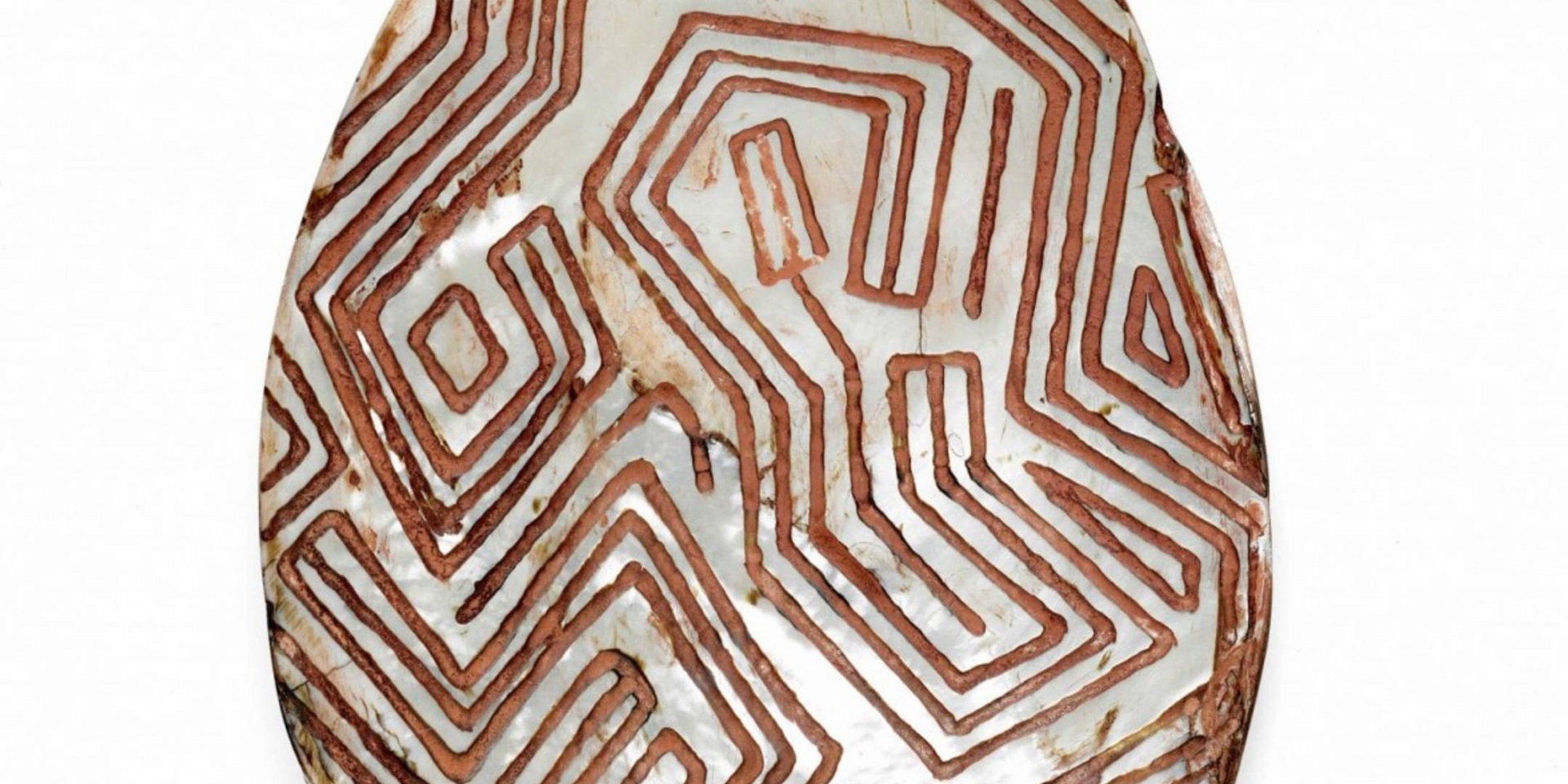
In the far north-west of Australia, a much larger shell offered people quite a different object to work with. The pearl shell, with its large flat shape, became a canvas upon which to inscribe designs. The shells were harvested off shore at very low equinox tides. People from the Buccaneer Archipelago used Gaalwa rafts constructed of mangrove logs fastened together with wooden pegs to visit offshore reefs. Both men and women were involved in different aspects of the harvesting, crafting and wearing of pearl shell.
The pearl shell, with its large flat shape, became a canvas upon which to inscribe designs.
The Kimberley coast was renowned for its incised and decorated pearl shell – known as riji or jakuli in the Bardi Jawi language. After gathering the shell, it would be opened and cleaned and have one to three attachment holes pierced by a stone flake. Some shells were not engraved, but most were incised on the lustrous inner face of the shell with ochre or charcoal infill.
Indigenous Western Australian shell pendant with a finely incised design. ANMM Collection 00045196.
Pearl shells were used in ceremonies such as initiation, rain-making and love magic and worn as body adornment, with large shells being worn by men as pubic coverings, tied around the waist with a belt of human hair. Smaller shells were also worn around the neck or tucked into headbands by both men and women; these were considered as informal wear, with the larger shells usually associated with more formal events such as ceremonies. The incised lines and engravings on the shells often identified clan groups, places or animals and held significant stories.
The shells were also traditionally associated with trade and exchange, water, magic and sorcery. Their incandescence and connection with rain-making linked them to the Rainbow Serpent, a creator god, and its manifestation as a rainbow. Flashes of light from the shimmering surface of the inner shell connected the shells to lightning and thus the production of rain clouds.
Man’s pubic ornament (phallocrypt) of carved pearl shell hung from a belt of human hair. ANMM Collection 0006918.
Shell necklace by Mavis Warrngilna Ganambarr features clusters of shells formed by stringing two parallel lines of shells together. PHOTOGRAPH BY ANDREW FROLOWS / AUSTRALIAN NATIONAL MARITIME MUSEUM.
The pearl shell’s connection to water was prominent. It has been described by the Bardi Jawi people as ‘an emblem of life itself’, with the seasonal re-awakening of the land after dry periods ‘embodied in the shell.’ In 1990 the Kimberley artist and Walmajarri elder Mumbadadi from Christmas Creek described pearl shell as ‘… for everybody – man and woman. This is rain. This everything water’. Thus the importance of pearl shells was great, both along the coast and for thousands of kilometres inland. Shells were traded in various routes across much of the Australian continent.
Since the mid-20th century shellwork has also been used to engage with various histories since colonialism. Today, artists from the Kimberley coast such as Gary and Darrell Sibosado are still creating riji. Their etched pearl shell designs have also been transformed into print media such as etchings and other graphic design, becoming an accepted part of Indigenous contemporary art.
The Torres Strait Islands were another important and rich location for pearl shells and also part of the often tragic history of the lucrative pearling industry in Australia. Here, shells – now harvested sustainably – continue to be a key material in the palette of artists who create items central to ceremonial performances, such as headdresses, masks, headbands, necklaces, breast ornaments and armlets. Pearl shell – often worn around the neck as a charm – conferred prestige on its owners, and can be found in the dhoeri and dari headdresses (the dari features on the Torres Strait Island flag). Contemporary artists such as Ricardo Idagi, Obery Sambo and George Nona use varieties of lustrous shells, including pearl shell.
Living Traditions
Shellwork has provided a means for Indigenous systems of knowledge to become embedded in contemporary art practices. The examples in the Living Waters exhibition are ecological narratives based on an intimate understanding of country to which Western science is only recently turning, as together we struggle with anthropogenic climate change.
The Oceanographic Museum of Monaco is committed to sharing knowledge about the oceans, and raising awareness of, and finding innovative solutions to, the dangers that threaten them. Initiated in 1910 by the museum’s founder, Prince Albert I, this approach was then carried forward by its successive directors – chief among them Captain Jacques-Yves Cousteau – and HSH Prince Albert II of Monaco, during his extensive travels around the world.
Living Waters, an exhibition of Indigenous Aboriginal and Oceanic art, will be held over six months and will be a major event of summer 2016 at the Oceanographic Museum. It aims to address its theme from various angles with diverse artistic approaches, different media and the involvement of a large number of artists. The primary link between the Oceanographic Institute and the Aboriginal and Pacific peoples is the Oceanographic Institute’s message about the protection of oceans and biodiversity. All the works in this exhibition have a relationship with the sea, sailing and water. The ANMM’s collection of shell objects and artworks will highlight the use of shells both in a traditional and contemporary context.
All images from the Australian National Maritime Museum Collection. Photographed by Andrew Frolows.
References
Akerman, Kim, and John Stanton (1994), Riji and Jakoli: Kimberley Pearlshell in Aboriginal Australia (Monograph Series 4; Darwin: Northern Territory Museum of Arts and Sciences)
Florek, Stan, ‘The Torres Strait Islands Collection at the Australian Museum’, Technical Reports of the Australian Museum, 19: 1–96, 2005
Knights, Mary, ‘This everything water’, DSSA Gallery, Adelaide Festival of Arts, 2008, available online through the University of Wollongong
‘Necklaces’, Aboriginal Heritage Tasmania, available online
Shimmer exhibition catalogue, Wollongong Art Gallery, Wollongong, NSW, 2015
